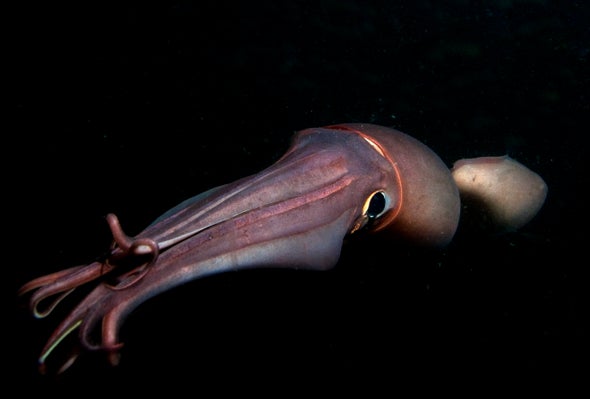(单词翻译:单击)
听力文本
This is Scientific American's 60-second Science, I'm Susanne Bard.
More than 1,500 feet below the surface of the ocean, it's darker than a moonless night. But even in this murky world, there's constant activity—including groups of Humboldt squid, each the size of a small adult human, darting around in search of fish.
"You can think of them as little rocket ships. They jet through the water. And they engage in these feeding frenzies. They're always looking out for an opportunity to eat."
Stanford University biologist Ben Burford. He says feeding in a group requires careful navigation.
"These animals are cannibalistic; they're pretty aggressive. So there's probably some risk to group living. We think a lot of the communication they do in these groups helps with that. Like, imagine driving in heavy traffic with a bunch of aggressive drivers, say down in Los Angeles. Thank goodness you have turn signals and brake lights and horns on your cars, because that prevents a lot of catastrophe from happening."
Burford thinks Humboldt squid communicate in the dark ocean by using their own form of signaling. They do it by turning their bodies into animated message boards. How? Like other cephalopods, they can rapidly change the pigmentation patterns on their skin by contracting and relaxing their muscles. What's more, their bodies can glow.
"They're creating a bioluminescent backlighting for their pigmentation patterns. So it becomes somewhat like an e-reader, something you can actually read in the dark. They're essentially just, you know, selectively revealing and concealing different parts of a glowing body, producing these patterns on top of a glowing body."

Burford suspected that the squids could be combining different pigmentation patterns to create complex signals.
"So each of those elements could mean something. And they might have the potential to combine them to generate more meanings."
To find out, his team attached cameras to remotely operated vehicles in order to study the squids' behavior.
"We looked at how they arranged their patterns in sequence during prey-capture events."
The researchers found preliminary evidence that the sequence of patterns varies consistently in specific contexts. For example, the squid tended to flicker when many other squid were around or darken when pursuing prey, only to change their pattern just before striking.
The study is in the Proceedings of the National Academy of Sciences.
Burford eventually hopes to do underwater experiments in which the squid are shown playbacks of their visual signaling—virtual glowing squid, if you will. Their reactions should be illuminating.
Thanks for listening for Scientific American's 60-second Science. I'm Susanne Bard.
参考译文
这里是科学美国人——60秒科学系列,我是苏珊娜·巴德。
海面以下1500多英尺的地方,比没有月亮的夜晚还要黑暗。但即便在这个阴暗的世界里,也有持续性活动,其中包括洪堡鱿鱼群,每只体型都如矮小成年人,它们在水中四处飞奔寻找鱼。
“你可以将它们想象成小型火箭船。它们在水中喷射。它们疯狂地进食。它们总在寻找进食机会。”
斯坦福大学的生物学家本·伯福德说到。他表示,群体进食需要仔细辨别方向。
“这些动物会同类相食;它们非常好斗。因此群体生活可能存在一定风险。我们认为它们在这些群体中进行的大量交流有助于避开风险。比如,想象一下在拥挤的交通中开车时,周围有一群好斗的司机,就像在洛杉矶那样。谢天谢地,你的车上有转向灯、刹车灯和喇叭,因为这能避免很多灾难的发生。”
伯福德认为,洪堡鱿鱼用自已的信号方式在黑暗的海洋中交流。它们将自己的身体变成活动留言板。如何做到?像其它头足类动物那样,它们可以通过收缩和放松肌肉来迅速改变皮肤上的色素沉着图案。此外,他们的身体可以发光。
“它们为色素沉着图案创造生物性发光的逆光。因此它们有点像电子阅读器,就是你可以在黑暗中阅读的东西。它们基本上会选择性地展现和隐藏发光身体的不同部位,在发光身体表面产生这些图案。”
伯福德怀疑洪堡鱿鱼能将不同色素沉着图案结合起来,创造出复杂的信号。
“因此每种元素也许都有其意义。它们可能将其结合起来制造更多意义。”
为了找到答案,他的团队将摄像机装在遥控水下航行器上,以研究鱿鱼的行为。
“我们观察它们在捕猎活动中如何按顺序安排图案。”
研究人员发现,初步证据表明,在特定环境中,图案顺序会持续变化。比如,周围有同类时,鱿鱼往往会闪烁发光;而在追捕猎物时,鱿鱼的颜色会变暗,只在攻击前改变图案。
这项研究发表在《美国国家科学院院刊》上。
伯福德最终希望能进行水下实验,给鱿鱼展示视觉信号回放,如果你愿意的话,这也称为虚拟发光鱿鱼。它们的反应应该很有启发性(发光)。
谢谢大家收听科学美国人——60秒科学。我是苏珊娜·巴德。
译文为可可英语翻译,未经授权请勿转载!
重点讲解
重点讲解:
1. in search of 寻找;寻求;
Rescue workers are digging through the rubble in search of other victims.
救援人员正在废墟中挖掘,以搜寻其他受害者。
2. engage in 参与;从事;
Nowadays, office workers rarely engage in regular exercise.
现在,上班族很少定期进行锻炼。
3. look out for 搜寻;
I'll look out for Mr Jackson and give him your message.
我要去找杰克逊先生,转达你的口信。
4. in order to 为了;以便;目的在于;
In order to get a complete picture, further information is needed.
为掌握全面情况,还需要详细资料。


